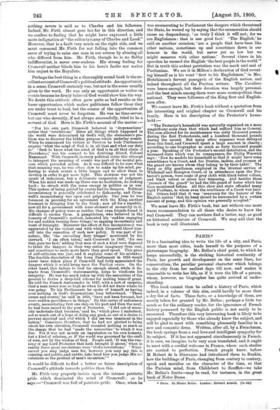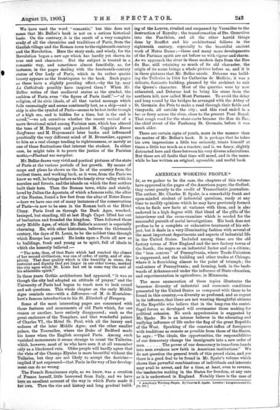PARIS.*
IT is a fascinating idea to write the life of a city, and Paris, more than most cities, lends herself to the purposes of a picturesque biography. Mr. Belloc's chief point, to which he keeps successfully, is the striking historical continuity of Paris, her growth and development on the same lines, her conservatism, the peculiar personal character which belongs to the city from her earliest days till now, and makes it reasonable to write her life, as if it were the life of a person, whom, however, no biographer has quite arrived at under- standing.
This book cannot then be called a history of Paris, which indeed, in a volume of this size, could hardly be more than a dry list of facts. These facts, or a knowledge of them, are mostly taken for granted by Mr. Belloc; perhaps a little too much so for the ordinary reader, for the ignorance of French history possessed by the English public is not easily to be measured. Therefore this very interesting book is likely to be enjoyed especially by those who already know the subject, and will be glad to meet with something pleasantly familiar in a new and romantic dress. Written, after all, by a Frenchman, the book springs from a real love and intelligent sympathy for its subject. If it has not appeared simultaneously in French, it is sure, we imagine, to be very soon translated, and it ought to meet with a cordial welcome in France, where such studies are carried to perfection. French people knew, before M. Robert de in Sizeranne had introduced them to Ruskin, how the buildings of Paris, changing from century to century, speak and moralise on the character of the time, so that the Parisian mind, from Childebert to Souffiot--we take Mr. Belloc's limits—may be read, for instance, in the great book of Notre Dame.
• Pares. By Hilaire Belloc. London : Edward Arnold. Us. ed.]
We have used the word " romantic," but this does not mean that Mr. Belloc's book is not on a serious historical basis. On the contrary, it is the result of a very complete study.of all the chronicles and traditions of Paris, from the Gaulish village and the Roman town to the eighteenth century and the Revolution. Here the story ends, and wisely, for the Revolution began a new age which has hardly yet shown its
true end and character. But the subject is treated in a romantic way, and sometimes almost fancifully, as, for instance, in the pages dealing with the fourteenth-century statue of Our Lady of Paris, which in its rather quaint beauty appears as the frontispiece to the book. Such pages as these have a slightly puzzling effect,—by the by, may La CatheVrale possibly have inspired them P When Mr.
Belloc writes of that medieval statue as the symbol, the emblem of Paris, even " the figure of Paris itself,"—" of its religion, of its civic ideals, of all that varied message which
fails unceasingly and seems continually lost, as a ship—and a ship is also the symbol of Paris—seems to be lost in the trough of a high sea, and is hidden for a time, but in the end is saved,"—we ask ourselves whether the recent revival of a more devotional mind among Parisian men, which has altered the tone of M. Bourget and produced M. Coppee's Bonne Soufrance and M. Huysmans's later books, and influenced
practically the very different mind of M. Brunetiere, appears to him as a real change tending to righteousness, or merely as
one of those fluctuations that interest the student. In either case, he might take it to prove the justice of the Parisian motto,—Fluctuat nec niergitur.
Mr. Belloc draws very vivid and poetical pictures of the state of Paris at the various periods of her growth. By means of maps and plans he shows us the lie of the country from the earliest times, and working back, as it were, from the Paris we know so well, he brings before us the lonely river valley with its marshes and forests, and the islands on which the first settlers built their huts. Then the Roman town, white and stately, loved by Julian the Apostate, of which a famous relic, the altar of the Nautae, found a few feet from the altar of Notre Dame —here we have one out of many instances of the conservatism of Paris—is now to be seen in the Roman bath at the Hotel Cluny. Paris lived on through the Dark Ages, wrecked, besieged, but standing, till at last Hugh Capet lifted her out of 'barbarism and founded the kingdom. Then followed those early Middle Ages, of which Mr. Belloc's account is especially charming. He, with other historians, believes the thirteenth century, the days of St. Louis, to be the noblest time through which Europe has passed: He looks upon a Paris all new as to buildings, fresh and young as to spirit, full of ideals in which she honestly believed The note, then, of that Paris which had reached the climax of her second civilisation, was one of order, of unity, and of sim- plicity. That dear quality which is like humility in stone, the restraint and dignity that yet linger in our older towns, marked the city upon which St. Louis had set in some way the seal of his admirable spirit."
In these years Gothic architecture had appeared, " it was as though the city had adopted an attitude of prayer," and the University of Paris had begun to teach men to look round and ask questions. This whole chapter on the early Middle
Ages reminds one—with a difference—of M. de Montalem- bert's famous introduction to his St. Elizabeth of Hungary.
Some of the most interesting pages are concerned with those features and monuments of old Paris which, for one reason or another, have entirely disappeared ; such as the great enclosure of the Templars, and that wonderful palace of Charles VI., the Hotel St. Paul, with all the luxury and sadness of the later Middle Ages ; and the other smaller palace, the Tournelles, where the Duke of Bedford made his home when the English occupied Paris. Among such vanished monuments it seems strange to count the Tuileries, which, however, most of us who have seen it at all remember only as a blackened ruin. Older people will hardly agree that the vista of the Champs Elysees is more beautiful without the Tuileries, but they are not likely to accept the doctrine— implied if not expressed—that Paris in the way of her develop- ment can do no wrong.
The French Renaissance style, as we know, was a creation of France herself, little borrowed from Italy, and we have here an excellent account of the way in which Paris made it her 'Own. Then the rise and history and long gradual build- ing of the Louvre, rivalled and surpassed by Versailles to the destruction of Royalty ; the transformation of Ste. Genevieve into the Pantheon, and all the other horrid things done by Soufflot and his architectural fellows in the eighteenth century, especially to the beautiful ancient work of Notre Dame ;—these and many more developments of the Parisian spirit are set before us with vigour and charm. As we approach the river in these modern days from the Rue du Bac, still retaining so much of its old character, the origin of its name brings a whole picture before us, and it is in these pictures that Mr. Belloc excels. Delorme was build- ing the Tuileries in 1564 for Catherine de Medicis; it was a delicate, fantastic building, planned by the architect to suit the Queen's character. Most of the quarries were by now exhausted, and Delorme had to bring his stone from the southern hill, now called Mont Parnasse. To avoid the delay and long round by the bridges he arranged with the Abbey of St. Germain des Pres to make a road through their fields and vineyards, all outside the city ; and this road ended in a bac or ferry across the river, close to the present Pont Royal. That rough road for the stone-carts became the Rue du Bac, the chief street of the Faubourg St. Germain, before it was much older.
There are certain signs of youth, more in the manner than the matter of Mr. Belloc's book. It is perhaps that he takes his own impressions a little too seriously, treats himself at times a little too much as a teacher, and is, we fancy, slightly distracted here and there between his very diverse admirations. But these are all faults that time will mend, and in the mean- while he has written an original, agreeable, and useful book.



































 Previous page
Previous page